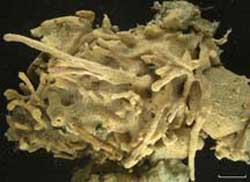
Thanks to the doggedness of a Cornell University marine biologist, researchers have discovered that one of Maine’s most important fishing areas has been invaded by an alien tunicate, or sea squirt, that could threaten the commercial fishing industry there.
A rapid assessment survey for marine invasive species in Cobscook Bay in August found a type of sea squirt — Didemnum sp. — that can damage ocean floor habitats and commercial species that live there. The survey was conceived

If you want to hear a little bit of the Big Bang, you’re going to have to turn down your stereo.
That’s what neighbors of MIT’s Haystack Observatory found out. They were asked to make a little accommodation for science, and now the results are in: Scientists at Haystack have made the first radio detection of deuterium, an atom that is key to understanding the beginning of the universe. The findings are being reported in an article in the Sept. 1 issue of Astrophysical Journal Lett
Complex chemotherapy cocktails offer about one extra month of life to patients with end-stage endometrial cancer but also can result in severe, possibly fatal, side effects, according to the first systematic review of studies addressing the topic.
“ The best drug treatment for women with advanced cancer of the womb is still not clear,” concludes the review, led by Dr. Caroline Humber of Walsgrave Hospital in England.
The review appears in the current issue of The Co
Tranquilizers work better than placebos at treating the symptoms of alcohol withdrawal syndrome but they may not work better than other drugs, according to a new review of recent studies.
The class of depressant drugs known as benzodiazepines are especially effective at treating seizure in withdrawal patients, say Dr. Christos Ntais of the University of Ioannina School of Medicine in Greece and colleagues. People given benzodiazepines were 84 percent less likely to have wi

What is the mysterious dark energy that’s causing the expansion of the universe to accelerate? Is it some form of Einstein’s famous cosmological constant, or is it an exotic repulsive force, dubbed “quintessence,” that could make up as much as three-quarters of the cosmos? Scientists from Lawrence Berkeley National Laboratory (Berkeley Lab) and Dartmouth College believe there is a way to find out.
In a paper to be published in Physical Review Letters, physicists Eric L
X-rays yield pictures and chemical clues that may help trace contaminants, thwart terrorists
As part of the search for better ways to track and clean up soil contaminants, scientists at the U.S. Department of Energy’s Brookhaven National Laboratory and Stony Brook University have developed a new way to “image” the internal chemistry of bacteria. The technique will allow scientists to “see” at the molecular level how soil-dwelling microbes interact with various pollutants. T